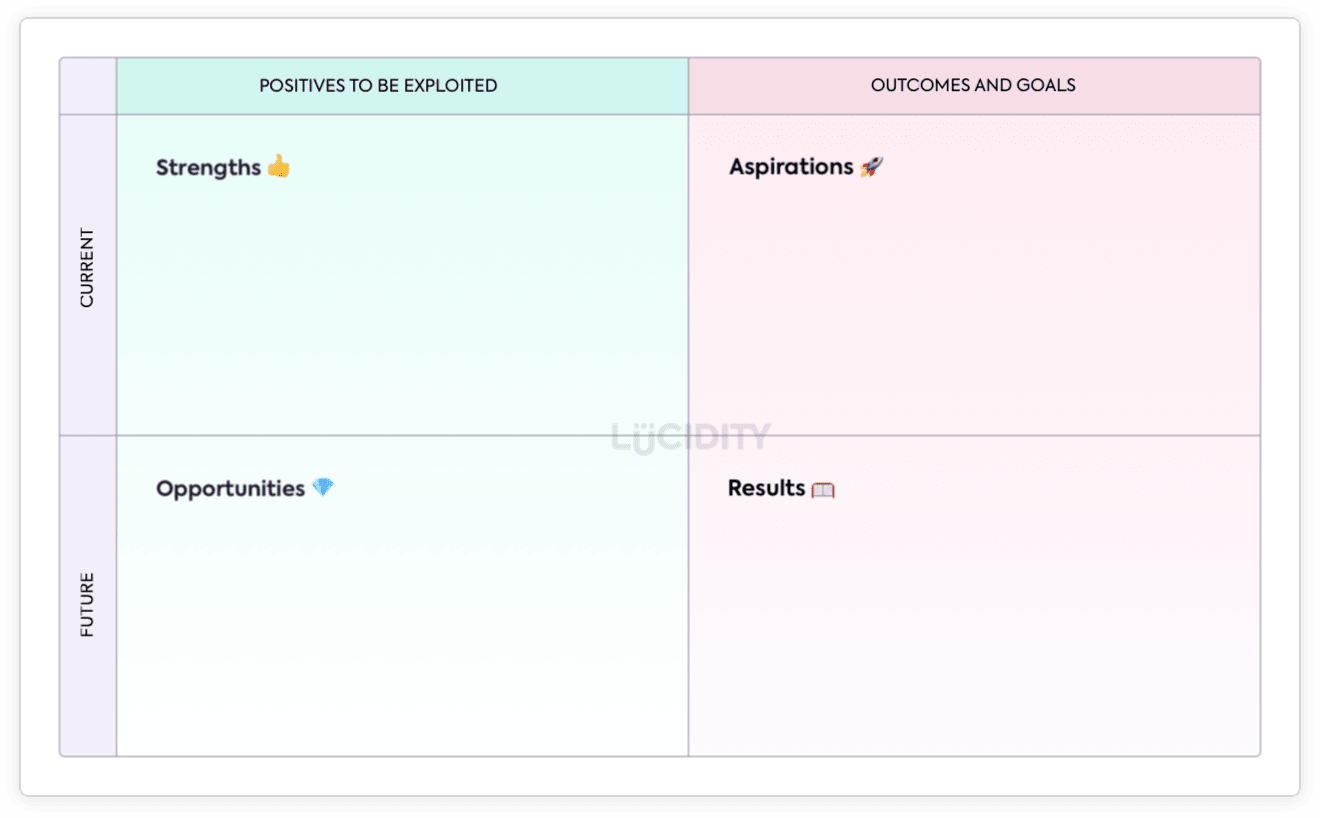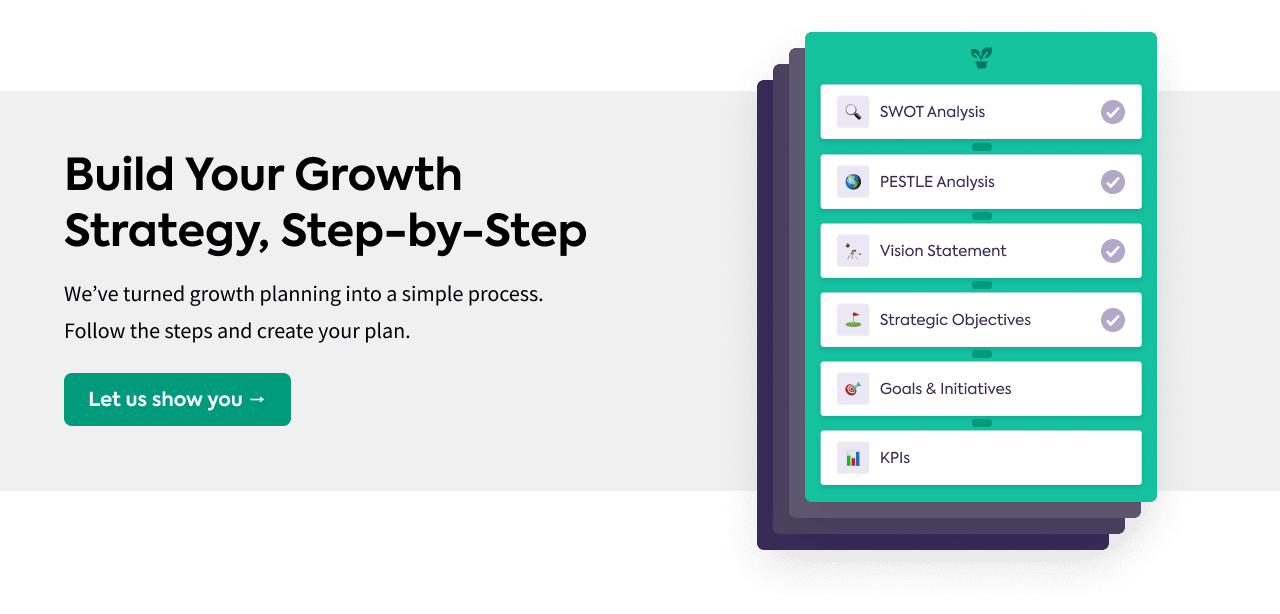A SOAR Analysis is another matrix but one that has the fairly rare quality of including the aspirations of a business. It’s a bit like your Company Vision had a baby with your SWOT! One of the biggest advantages of a SOAR is you can use it internally to help communicate out your strategy to all employees, as it contains only positives.
If you’re like to learn a little more before we start, check out our Introduction to SOAR Analysis before you read this.
The SO part of the SOAR focuses on your internal business, it’s populated by looking at resources, products, processes. The AR is all about your Aspirations, where do you want to get to, and about measuring your success via Results.
There are no negatives in SOAR – only positives – so we strongly recommend you’d complete a SWOT Analysis before you put together your SOAR otherwise you could miss key factors to consider in your strategic thinking.
Step 1 – List Your Strengths
If you’ve already created a SWOT then you have done this section – skip to Step 3.
Brainstorm your strengths as a business and ensure a complete and detailed list. Place as many as possible, because you’ll be refining these later. Make sure you’ve been through your entire business. It can often help to think of your client journey, all the touch points, and your sales messaging during this stage.
Example Generic Strength Areas:
- Brand recognition / value
- Supplier relationships
- Product feature set
- Skills
- Experience
- Client relationships
Helpful Questions:
- What’s your sales USP?
- Why will/do clients pick you over the alternatives?
- What are the backgrounds of your employees?
- How have you responded to market changes?
- What’s a success story of the business and why?
- What are the owner profiles?
Once you’ve devised your strengths list it’s time to refine them. This involves removing duplicates, making sure you’re as specific as possible, and ensuring that they are accurate. A good SWOT will have a decent list of strengths but it won’t be so many that it becomes overwhelming. Take a step back and evaluate each one, is it really a strength that gives you an edge or value, or is it just something that is a decent BAU positive?
Step 2 – Look for Opportunities
If you’ve created a SWOT then you have done this section – skip to Step 3.
In a similar manner to how you looked at your strengths, this section is a brainstorming for the opportunities in your market.
Example Generic Opportunities Areas:
- Example product to new market
- Create new feature for new trend
- International expansion
- New transport/delivery options
- Market consolidation
- M&A
Helpful Questions:
- What are the technological trends impacting your clients?
- Would your product work overseas?
- Is there another market your products would work on?
- What problems can you solve with your skill-base?
- What do clients ask for?
- How do your Strengths and Weaknesses convert to Opportunities?
Refinement for Opportunities can come by identifying the key ones that would add value to the business. It’s important to recognise what is an Opportunity for the business vs what is correcting a fault. This is sometimes hard to define, for example if there is no SLA in a company service team, is it an Opportunity to add it in, thus improving service, or not? There is no right or wrong answer, but the purpose of this is to propel the business forward, so consider BAU improvements as take-away key actions but not Opportunities.
Step 3 – Review Positioning Analysis
At this point you have a full SO analysis, giving you a picture of your business strenths and the opportunities ahead of you. Take a step back and review both lists together, is there anything missing, or have you a complete picture?
If you’re happy it’s time to move on to your future.
Step 4- Aspirations
At this point in the framework we’re going to brainstorm what you want to achieve in the future. It’s helpful to have your vision in mind (if you haven’t got one yet – now’s a good time to create a company vision!). Kickstart the process by listing what inspires you, where you feel the company will head, what are your core objectives? Remember to keep referring to the list of Opportunities and Strengths you’ve made.
Remember to keep metrics out of this section – they’ll come into play in Results next.
Example Generic Aspirations:
- Develop a product roadmap
- Have loyal customers
- Become market leader
- Enter new geographic market
Helpful Questions:
- What does the business look like in the future?
- What are the best opportunities for you?
- Where will success be for you?
- What do you want to achieve?
Once you’ve listed your Aspirations it’s time to refine them. Do they hold true to the company? Do they match your values?
Hint: They should be very similar to or have overlap with your Strategic Objectives.
Step 5 – Measure Using Results
The Results section of the SOAR framework is where you measure success. It’s about the metrics that you will use to hold your strategy to account. Refer back to your aspirations, each one should have at least one associated result.
Example Generic Result Areas:
- Increase x% in revenue
- Sales target of Y
- NPS for customers of Z
- Employee turnover less than x%
- L&D budget 100% spent
Helpful Questions:
- How is each aspiration going to be measured?
- What are the important KPIs for your business?
- What is realistic given your current position?
- How do you currently measure performance?
You should now have a complete set of Aspirations and Results, born from considering the previous parts of the SOAR. It’s now time for the final refinement. Sanity check the aspirations can be measured by the results, make sure you can obtain the data in order to measure it, and that it all feels achievable.
Remember to put a timeframe on the SOAR…
Now for one bonus steps to go the extra mile! 🏃
Step 6 – Shout About It
One of the biggest advantages of a SOAR is it’s completely positive, making it perfect for sharing round the employees of the business. You can use your SOAR to help explain your strategy, your direction and what you hope to achieve. A good SOAR can be key to employee engagement… and remember it doesn’t need to be presented in a matrix, you can break it out and place it into slides or a pdf.
We hope you found this guide helpful. To access more content, models and frameworks sign up for Lucidity today!














